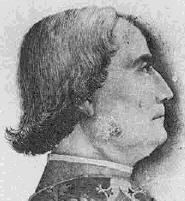Jacopo Antonio Marcello (1398 - 1463)
|
Marcello was a man with many functions for the Venetian state, finally in a position, where he even might have become doge of the state. In 1449 he fought together with Francesco Sforza (his function was then provviditore, this means, he was a central person between Venetian senate and condottieri, he organized the war activities according the wishes of the senate).
He sent a famous parcel to Isabelle de Lorraine with two packs of cards (our main theme). He sent another gift to René d'Anjou in the early 50ies with a manuscript about the life of St. Maurice (a Soldier Saint, here a short description and some pictures, occasionally painted as "black" soldier). In the specific context Rene d'Anjou had founded the Order of the Crescent in 1448, a knight's order, one of his many romantic actions (somehow successful actions, cause in 1453 France did win the 100-years war). In unclear way Francesco Sforza and Marcello became members to this order with the numbers 17 and 18, perhaps 1452 - the manuscript about St. Maurice seem to refer to this membership). Around 1457 another gift followed, this time a Strabo translation (compare our report). A 4th gift might have been prepared before his death (compare Dokument 26b) An Angelo Marcello di Venezia is in 1432 noted as Priore di Venezia to the Knights of the Order of St. John of Jerusalem, the order is in the possession of institutions, which belonged earlier to the Templars, perhaps Jacopo Antonio Marcello was already from a familiary relationship predestined to be interested in Knight's orders and especially in René d'Anjou, who beside other titles also was called King of Jerusalem. The book paintings from the Maurice manuscript are done either by Mantegna or Girolamo da Cremona, a friend of Mantegna. Marcello retired from militaric life in his later years, spending his time in his home at Monselice, being totally fond of a talented son and became Podesta in Padua. In this function he ordered paintings of the holy Sebastian from Mantegna. Mantegna got in this time 3 letters from Ludovico Gonzaga, which finally (1459, at the time of the congress of Mantua) did lead the artist to Mantua, where he more or less stayed for the rest of his life. Marcello's talented son Valerio died with 8 years in 1461. The father received many consolation letters from great humanists of the time, and tried to compose out of them a manuscript, which was intended (again) to be presented to Rene d 'Anjou. The interests of the humanists in Marcello show, that he has been regarded as a great sponsor of the arts. He couldn't finish his work, he died 3 years after Valerio's death. Jacopo Antonio Marcello was rather unknown until recently, when Margareth L. King published about his book project after the death of his son. Marcello's family became successful in late 15th century (a doge with the the name Marcello in 1474/75), perhaps due to some success of Jacopo Antonio Marcello. More material to Marcello from us is in the articles
|
 |